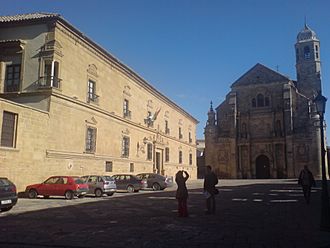Palacio del Deán Ortega, Úbeda facts for kids
Quick facts for kids Palacio del Deán Ortega |
|
|---|---|
 |
|
| Alternative names | Parador de Úbeda |
| Hotel chain | Paradores |
| General information | |
| Location | Úbeda (Jaén), Spain |
The Palacio del Deán Ortega is a beautiful old palace located in the historic city of Úbeda, in the Province of Jaén, Spain. It's a fantastic example of Renaissance architecture and has a rich history, dating back to the 16th century. Today, it's not just a museum; it's also a special hotel where people can stay and experience history firsthand!
Contents
What is the Palacio del Deán Ortega?
This grand building was once the home of an important church official. A "Deán" (Dean) is a high-ranking priest, similar to a leader of a group of priests in a cathedral. The palace was built for Fernando Ortega Salido, who was the Dean of the Cathedral of Málaga. He wanted a magnificent home in his hometown of Úbeda.
A Glimpse into History: When Was It Built?
The Palacio del Deán Ortega was built in the 16th century, which means it was constructed sometime between the years 1501 and 1600. This was a time known as the Renaissance in Europe, a period of great artistic and cultural growth. The palace was finished around 1540.
Who Built This Palace?
The person who designed and oversaw the building of the palace was a famous architect named Andrés de Vandelvira. He was very well-known for his work in the Jaén province during the Renaissance. He designed many important buildings, and the Palacio del Deán Ortega is one of his masterpieces.
Renaissance Style: What Does It Look Like?
The palace is a great example of Renaissance architecture. This style is known for its:
- Symmetry: Both sides of the building often look the same or are perfectly balanced.
- Order: Everything is carefully planned and organized.
- Classical elements: You might see columns, arches, and decorative details inspired by ancient Roman and Greek buildings.
The Palacio del Deán Ortega features a lovely courtyard, which is a common feature in Spanish palaces. It also has beautiful stone carvings and detailed windows that show off the artistic skill of the time.
From Palace to Parador: Its Modern Use
Today, the Palacio del Deán Ortega is no longer a private home. It has been transformed into a "Parador." A Parador is a special type of hotel in Spain. The Paradores hotel chain takes historic buildings, like old castles, monasteries, or palaces, and turns them into unique hotels. This allows people to stay in places with a lot of history and enjoy their beauty.
Staying at the Parador de Úbeda means you can sleep in a room that was once part of a 16th-century palace! It's a unique way to experience Spanish history and culture.
Why Is It Important?
In 2003, the Palacio del Deán Ortega was officially declared a Bien de Interés Cultural. This Spanish term means "Property of Cultural Interest." It's a special protection status given to buildings, sites, or objects that are very important to Spain's history, art, or culture. This declaration helps make sure the palace is preserved and protected for future generations to enjoy.
The palace is also part of Úbeda's larger historical heritage. Úbeda, along with its nearby sister city Baeza, is a UNESCO World Heritage Site. This means the entire historic center of Úbeda is recognized internationally for its outstanding universal value, especially its Renaissance architecture. The Palacio del Deán Ortega is a key part of what makes Úbeda so special.
See also
 In Spanish: Palacio del Deán Ortega para niños
In Spanish: Palacio del Deán Ortega para niños

